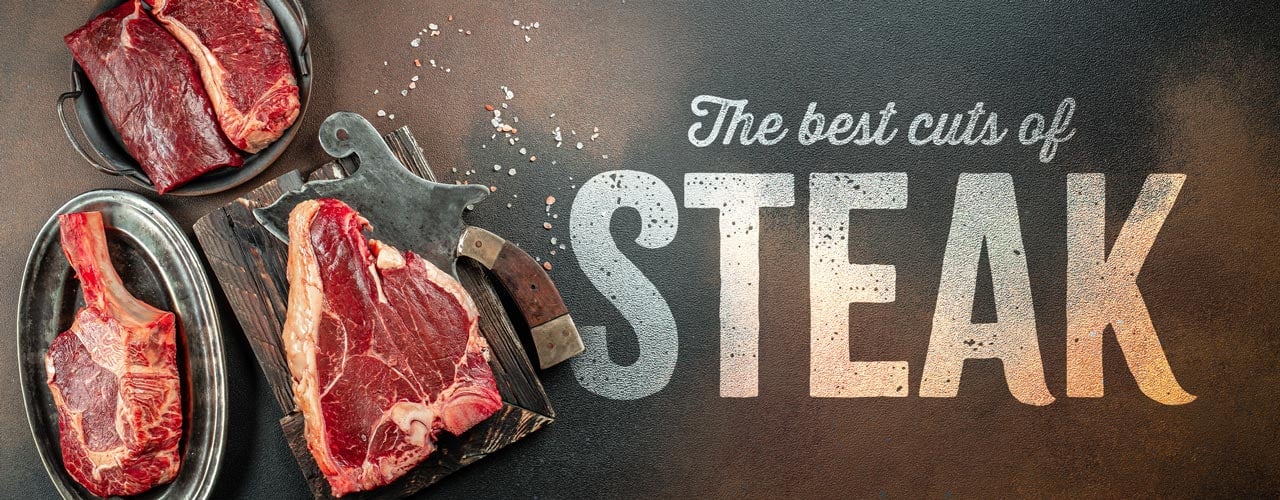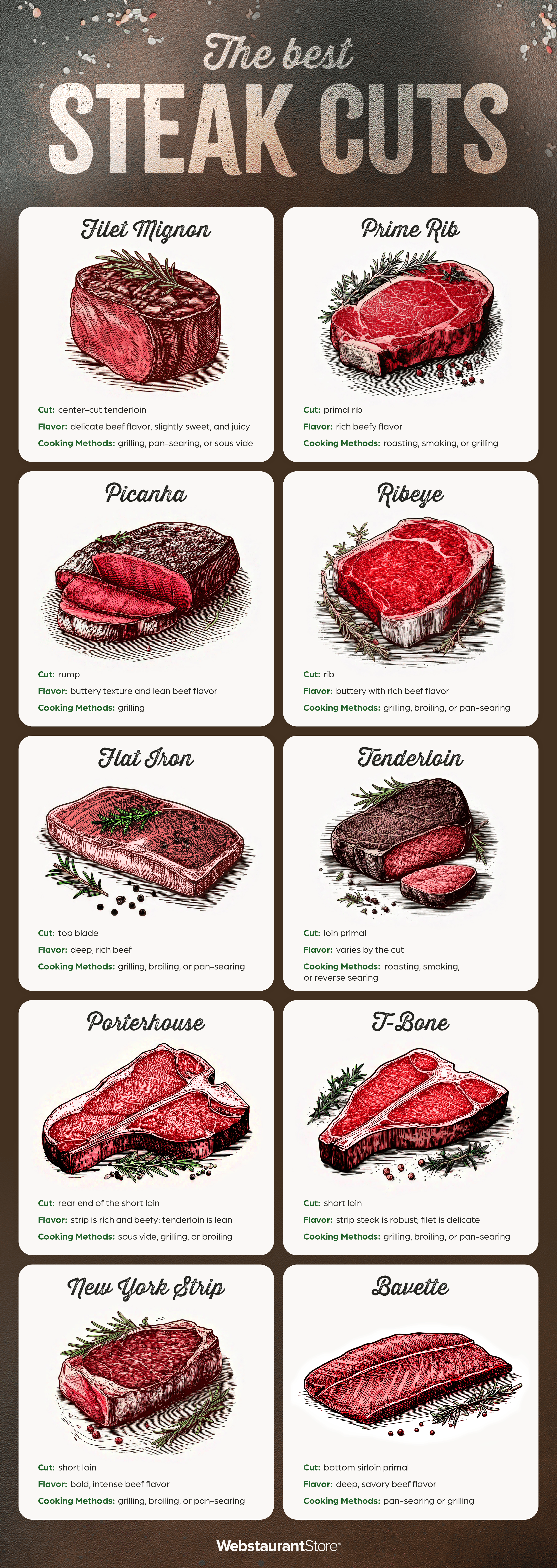Filet mignon, prime rib, and porterhouse steaks are excellent cuts of meat with distinctive features that differentiate them, such as where it's found, the texture, and its consistency. Our guide to the best cuts of steak explains what distinguishes each steak so you can choose the best cuts for your preparation method. Once you understand what the best cuts of steak are, acquaint yourself with the different grades of beef to select the best quality meat.
Best Cuts of Steak in Order
We’ve arranged the top 10 best cuts of steak in order of quality so you can see the top contenders while picking what works best for your menu and target clientele.
1. Filet Mignon
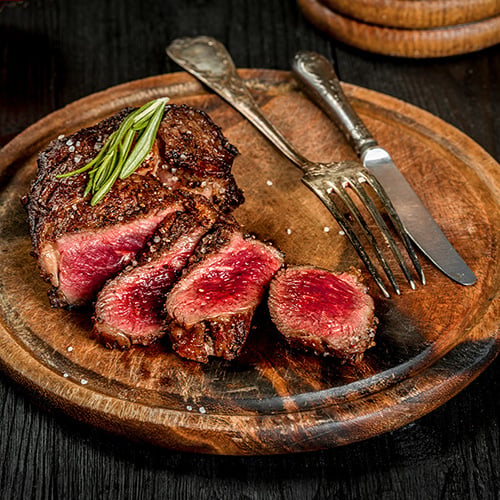
Filet mignon is considered one of the most luxurious and expensive beef cuts prized for its tender and buttery texture. It comes from the center cut of the tenderloin, which is a long, cylindrical muscle located along the spine of the cow. This muscle is not weight-bearing, which means it doesn't do much work during the cow's lifetime. As a result, the meat from this area is incredibly tender. The name "filet mignon" is derived from French, with filet meaning "thick slice" and mignon meaning "dainty" or "delicate." This name accurately describes the cut, as filet mignon is typically a small, round steak cut into thick slices.
One of the defining characteristics of filet mignon is its lack of fat marbling. It's prized for its lean and tender meat. Due to its tenderness, filet mignon can be cooked using various methods, including grilling, pan-searing, or sous vide. Filet mignon cooks quickly due to its lean nature, so it is crucial to monitor the internal temperature to prevent overcooking. When serving filet mignon, chefs often pair it with rich and flavorful espagnole sauce or toppings to enhance its taste. Popular accompaniments include mushroom sauce, red wine reduction, or a compound butter.
- Cut: Center-cut tenderloin
- Flavor: Delicate beef flavor, slightly sweet, and juicy
- Cooking Methods: Grilling, pan-searing, or sous vide
2. Prime Rib
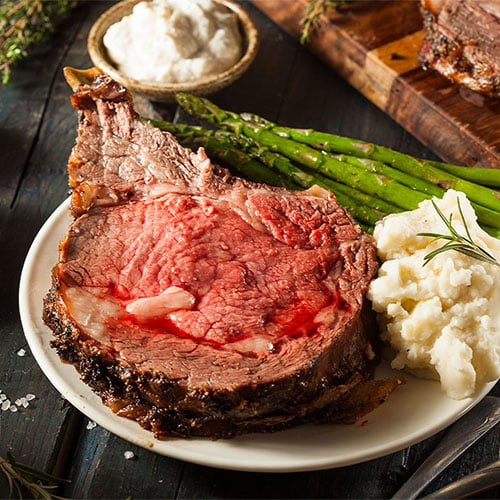
Derived from the rib section of the cow, the primal rib is the cut of beef that produces prime rib, which extends from the 6th to the 12th rib. This section is located between the chuck and the loin, closer to the front of the animal. What sets prime rib apart from other cuts of steak is its marbling, which refers to the intramuscular fat that is distributed throughout the meat. This marbling gives prime rib its exceptional flavor and tenderness, making it a favorite among steak lovers. When selecting prime rib, look for well-marbled meat with a good amount of fat evenly distributed throughout. This fat helps keep the meat moist and adds flavor during the cooking process.
Butcher shops typically sell prime rib as a bone-in roast, which adds to its juiciness. The bone acts as an insulator, helping retain moisture and imparting a depth of flavor to the meat. However, boneless prime rib is also available for those who prefer a more convenient option. Cooking prime rib is a culinary art that requires careful attention to detail. It is often prepared using dry-heat cooking methods such as roasting or grilling to enhance its natural flavors. Smoked prime rib is a show-stopping menu item. The slow cooking process allows the fat to render and baste the meat, resulting in a tender and juicy steak. Caterers often serve prime rib as a centerpiece for special occasions and holidays. It pairs well with a variety of side dishes, such as mashed potatoes, roasted vegetables, and a rich red wine sauce.
- Cut: Primal rib
- Flavor: Rich beefy flavor
- Cooking Methods: Roasting, smoking, or grilling
3. Picanha

Picanha, also known as sirloin cap or rump cover, is a popular cut of steak that originates from Brazil and is popular throughout South America, particularly Argentina. Picanha comes from the top of the rump, specifically the cap muscle that surrounds the top sirloin. This muscle is well-marbled, which contributes to its rich, juicy flavor. One of the distinguishing features of picanha is the thick layer of fat that covers one side of the steak. This fat cap adds an incredible amount of flavor and moisture to the meat while it cooks. As the fat renders and melts during cooking, it bastes the steak, enhancing its taste and juiciness. This fat cap also helps protect the meat from drying out.
When cooking picanha, it is best to keep it simple. The rich flavor of the meat shines through with minimal seasoning. A popular way to prepare picanha is to season it with coarse salt and pepper, allowing the natural flavors to take center stage. Grilling is the preferred method for cooking picanha, as it allows the fat to render and create a delicious crust on the outside while keeping the inside tender and juicy. Picanha is often served sliced thin against the grain, which helps to further enhance its tenderness. This cut of steak is incredibly versatile and can be enjoyed on its own or as part of an array of asado (Argentinian BBQ) offerings. It pairs well with traditional Brazilian sides such as farofa (toasted cassava flour), feijoada (black bean stew), or even a simple chimichurri sauce.
- Cut: Rump
- Flavor: Buttery texture and lean beef flavor
- Cooking Methods: Grilling
4. Ribeye

Derived from the rib section of the cow, ribeye is also referred to as a ribeye steak or a rib steak. One of its standout qualities is its marbling, which creates a rich, buttery flavor. It’s typically boneless, although bone-in ribeye steaks, also known as cowboy steaks, are also available. The bone-in ribeye adds an extra layer of flavor and juiciness to the meat. It is often preferred by those who enjoy a more rustic and traditional steak experience.
Ribeye steak is best suited for dry-heat cooking methods such as grilling, broiling, or pan-searing. The high-fat content of the ribeye helps keep the meat moist and tender during the cooking process. Whether cooked to rare, medium-rare, or medium, the ribeye delivers a succulent and flavorful eating experience. Its rich, juicy flavor pairs well with a variety of side dishes like grilled vegetables, sauteed mushrooms, and crispy onions.
- Cut: Rib
- Flavor: Buttery with rich beef flavor
- Cooking Methods: Grilling, broiling, pan-searing
5. Flat Iron

The flat iron steak comes from the shoulder region of the cow, specifically from the top blade muscle. It is named after its shape; it resembles a traditional flat iron used for ironing clothes. Flat iron steak is known for its tenderness and rich marbling. It offers a robust, beefy flavor that is often compared to a ribeye or a New York strip steak. Due to its popularity and tenderness, the flat iron steak offers a high-quality dining experience at a more affordable price compared to other premium cuts of steak.
One of the reasons flat iron steaks are so tender is they lack the connective tissue found in other tougher cuts of beef. However, it does have a thin strip of gristle running through the center, which you should remove before cooking to enhance the dining experience. It's versatile and can be cooked using various methods such as grilling, broiling, or pan-searing. Due to its tenderness, the perfect steak doneness for flat iron steak is between medium-rare or medium doneness to fully appreciate its flavor and texture. When serving the flat iron steak, slice it against the grain to maximize its tenderness and reduce chewiness.
- Cut: Top blade
- Flavor: Deep, rich beef
- Cooking Methods: Grilling, broiling, or pan-searing
6. Tenderloin
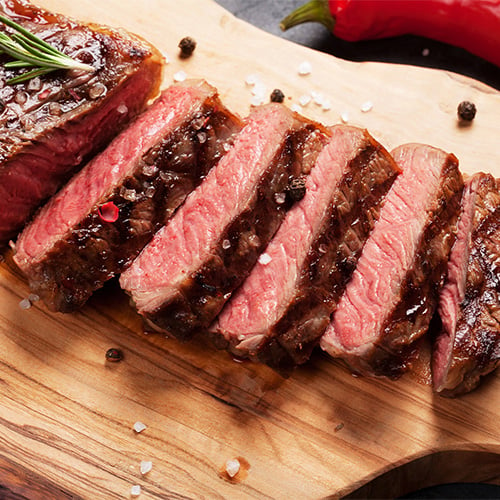
Tenderloin earned its name from its tender and buttery texture. The beef tenderloin is a cylindrical cut of beef that spans two primal cuts: the short loin and the sirloin. It is located beneath the ribs, next to the backbone. The tenderloin has two ends: the butt and the "tail." The butt end is thicker and wider, while the tail end is narrower and tapers off. Both ends can be used to create delicious and tender steaks, although they may have slightly different shapes and sizes. The tenderloin is a non-weight-bearing muscle, which means it doesn't have to work as hard as other muscles in the cow. This lack of exercise contributes to its tender texture. Whether you grill, roast, or pan-sear the tenderloin, the key is to cook it slowly and at a low heat to achieve a perfect medium-rare doneness.
Butchers divide the tenderloin into three main cuts: the butt, the center cut, and the tail. Each of these cuts offers a slightly different flavor profile and shape, allowing chefs and restaurateurs to choose the one that best suits their culinary needs. The most popular and well-known portion is the center cut, which is often referred to as filet mignon. The larger end of the tenderloin, known as the butt end or head of the tenderloin, is the thickest part of the muscle. It is located closer to the rear of the animal and is known for its robust flavor. The butt is often used for roasts or beef Wellington. The tail is the narrowest and smallest portion of the tenderloin. It is located towards the rear of the animal and is known for its delicate flavor. The tail is often used for smaller steak portions, or it can be used in dishes that require thin slices of steak, like stir-fries or beef stroganoff.
- Cut: Loin Primal
- Flavor: Varies by the cut
- Cooking Methods: Roasting, smoking, reverse searing
7. Porterhouse

What sets the Porterhouse steak apart is its unique composition. It comes from the rear end of the short loin, which is between the rib and sirloin sections of the beef. This positioning allows the porterhouse to contain two different cuts of steak: the center cut of tenderloin and the strip steak. The center cut of tenderloin, also known as filet mignon, is the most tender and delicate part of the beef. It is prized for its melt-in-your-mouth texture and subtle flavor. On the other hand, the strip steak, also known as the New York strip or sirloin strip, is a well-marbled cut with a rich, beefy flavor and a slightly firmer texture. Butchers typically cut the porterhouse steak to include a generous portion of both the tenderloin and the strip steak. The U.S. Department of Agriculture (USDA) specifies that for a steak to be labeled as a porterhouse, it must have a tenderloin section that measures at least 1 1/4 inches in width.
Due to its size and combination of two distinct cuts, the porterhouse steak is considered a showstopper on the plate. It is commonly served as a centerpiece for special occasions or shared between two people. When cooking the porterhouse steak, it is important to consider its size and composition. Due to the presence of the tenderloin, which is more delicate and cooks faster than the strip steak, we recommend using a cooking method that allows for even heat distribution. Grilling and broiling are popular methods that help to achieve a nicely charred exterior while maintaining a juicy and tender interior.
- Cut: Rear end of the short loin
- Flavor: The strip side is rich and beefy and the tenderloin portion is lean
- Cooking Methods: Sous vide, grilling, broiling
8. T-Bone

A T-bone steak is cut from the short loin of the cow, which is located in the upper middle section of its back. This area is known for its tenderness and marbling, which gives the T-bone steak its rich, juicy flavor. One of the main distinguishing features of the T-bone steak is the presence of the bone. The bone in the center of the steak is a combination of beef tenderloin and strip steak. On one side of the bone, you have the tenderloin, which is known for its tenderness and buttery texture. On its other side, you have the strip steak, also known as the New York strip or the Kansas City strip. The strip steak is slightly less tender than the tenderloin but makes up for it with its intense, beefy flavor.
When cooked properly, the T-bone steak offers the best of both worlds. The tenderloin section is incredibly tender and has a melt-in-your-mouth texture, while the strip steak section provides a satisfying chew and a robust umami flavor. The T-bone steak is typically cooked using dry heat methods such as grilling, broiling, or pan-searing to bring out its natural flavors and create a delicious crust on the outside. While both porterhouse and T-bone steaks include bones and are cut from the short loin, the porterhouse is cut from the rear of the short loin, and T-bone steaks are cut from the front of the short loin. T-bones contain a smaller section of the tenderloin than porterhouse steaks.
- Cut: Short Loin
- Flavor: The strip steak portion offers a robust, beefy flavor, and the filet mignon portion supplies a delicate, beefy flavor
- Cooking Methods: Grilling, broiling, or pan-searing
9. New York Strip

New York strip steak, also known as striploin or top loin steak, is a boneless cut that comes from the short loin of the cow, located behind the ribs and above the sirloin. The New York strip steak is known for its bold, beefy flavor. It has a slightly firmer texture compared to other cuts, such as the ribeye or tenderloin, but it is still incredibly tender when cooked properly. The steak has a good balance of lean meat and fat, making it an excellent choice for grilling, broiling, or pan-searing.
When it comes to cooking a New York strip steak, it is best to keep it simple to let the natural flavors shine. Season the steak with salt and pepper, and then cook it over high heat to achieve a delicious crust on the outside while keeping the inside juicy and tender. The steak tastes delicious when prepared to various levels of doneness, ranging from rare to well-done, depending on personal preference.
- Cut: Short loin
- Flavor: Bold, intense beef flavor
- Cooking Methods: Grilling, broiling, pan-searing
10. Bavette

Bavette steak, also known as flap steak or sirloin tip, is derived from the bottom sirloin primal. It’s typically long and thin, with a coarse texture. The bavette steak is renowned for its rich, beefy flavor and tender, juicy texture. It’s well-marbled, adding flavor and juiciness to the steak while keeping it tender during cooking. When cooked to perfection, bavette steak develops a beautiful, caramelized crust on the outside while remaining tender and juicy on the inside. In terms of tenderness, bavette steak falls somewhere between a skirt steak and a flank steak. While it may not be as tender as a filet mignon or a ribeye, it offers a more affordable option without compromising flavor.
An advantage of bavette steak is its versatility in the kitchen. Due to its thinness and relatively large surface area, it cooks quickly and evenly, making it an excellent choice for grilling, pan-searing, or broiling. Its robust flavor pairs well with a variety of homemade spice blends and marinades, allowing for endless possibilities for creating flavor profiles. With proper cooking techniques, such as marinating or using a meat tenderizer, bavette steak can be quite delicious.
- Cut: Bottom sirloin primal
- Flavor: Deep, savory beef flavor
- Cooking Methods: Pan-searing or grilling
The best cut of steak will depend on personal preference and the desired dining experience. Whether you prefer a tender and juicy ribeye, a buttery filet mignon, a robust New York strip steak, or the combination of flavors in a T-bone steak, there is a cut that will satisfy every steak lover's palate.
Printable Version